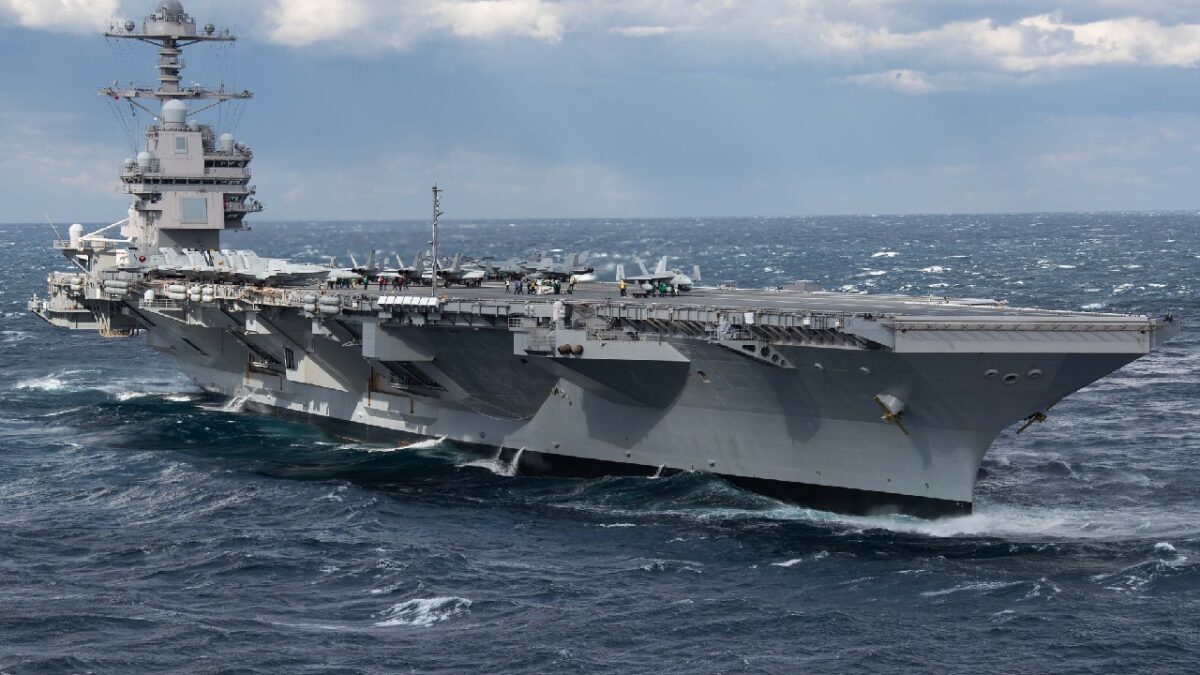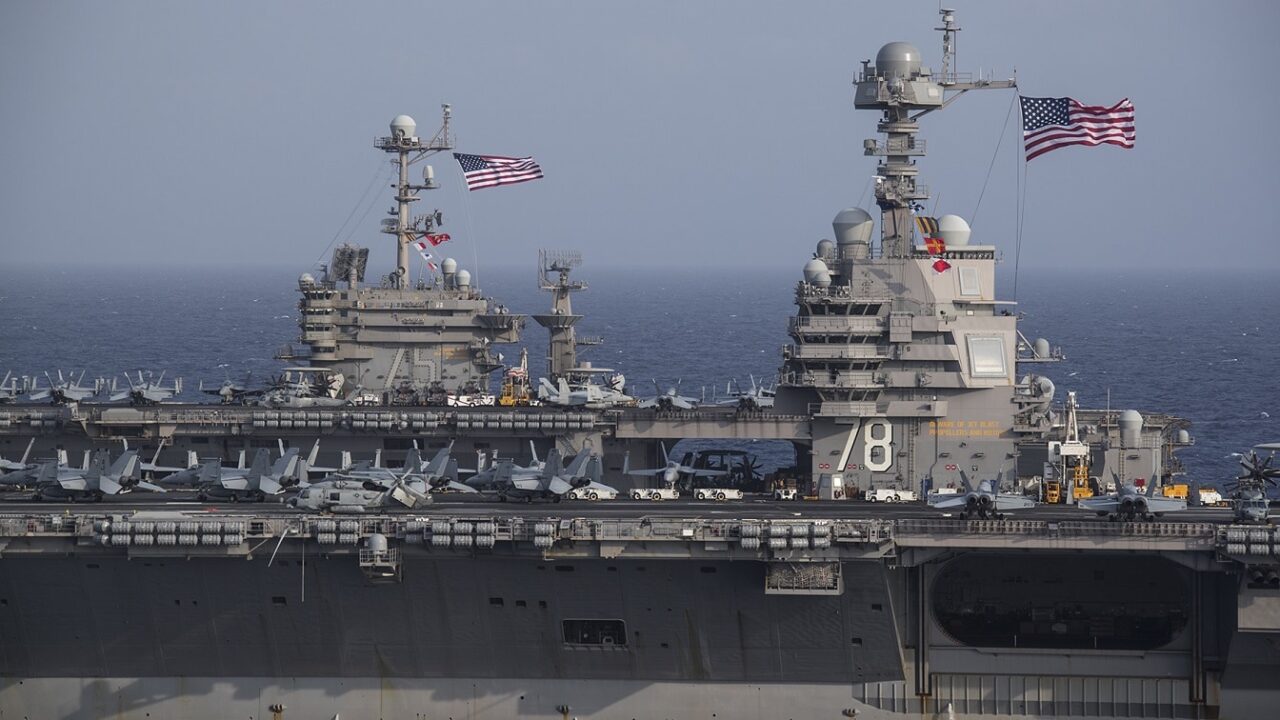The U.S. Navy’s largest aircraft carrier, the USS Gerald R. Ford (CVN-78) acheived a new milestone this week. The first-in-class supercarrier and her crew arrived in Halifax, Nova Scotia, for the ship’s first international port visit on Oct. 28. After years of delays, the warship finally left from Norfolk, Virginia, on Oct. 4, beginning her first deployment. The ship has been conducting maritime exercises and operations in the Atlantic Ocean with NATO allies Canada, Spain, Denmark, the Netherlands, and Germany.
This first deployment included that port-of-call visit to our neighbor to the north.
“We have been operating alongside our Allies and partners on the high seas, training our interoperability and interchangeability,” said Capt. Paul Lanzilotta, commanding officer of the USS Gerald R. Ford. “Visiting Halifax gives us a chance to build even stronger relationships with our teammates, strengthening our partnership, and allows our Sailors to explore the rich culture and welcoming people of Canada.”
CVN-78 was also the first U.S. carrier to visit Halifax in five years, and the choice of destination affirmed a deeper connection between USS Gerald R. Ford and Halifax, which is Norfolk’s sister city. The visit allowed many of the carrier’s junior sailors not only their first international port experience, but also their first exposure to Canadian culture.
During the recent visit, Commander, U.S. 2nd Fleet, Vice Adm. Daniel Dwyer, and the U.S. Ambassador to Canada, David Cohen, co-hosted a reception that further highlighted the long-standing bilateral alliance between the U.S. and Canada.
“This inaugural deployment is a gift,” said Adm. Dwyer. “It has brought an amazing group of allies and partners together for a short period of time, for a single focus, and it has given us an amazing opportunity to train together and better understand how to work alongside each other so that we can move forward with a strengthened purpose and resolve.”
USS Gerald R. Ford: Back to Sea
On Tuesday morning, the carrier departed Halifax. The official social media account for USS Gerald R. Ford (@Warship_78) shared photos from the recent visit and announced, “That’s a wrap for #Halifax! #Warship78 completed its first foreign port visit last week and is now steaming in the #Atlantic ocean.”
Having completed the port visit, the Gerald R. Ford Carrier Strike Group is now scheduled to continue its deployment in the Atlantic Ocean, conducting training and operations alongside NATO Allies and partners to enhance integration for future operations and demonstrate the U.S. Navy’s commitment to a peaceful, stable and conflict-free Atlantic region.
Ford Facts
The USS Gerald R. Ford is a first-in-class aircraft carrier and the first new carrier designed in more than 40 years. Developed as part of the Navy’s CVN 21 program, CVN-78 will consist of a planned total of 10 carriers. They will replace the current Nimitz-class carriers on a one-for-one basis.
Built by Huntington Ingalls Industries’ Newport News Shipbuilding, the carrier is 1,092 feet in length and has a beam of 134 feet, while the flight deck is 256 feet wide. The USS Gerald R. Ford displaces approximately 100,000 long tons and is powered by two nuclear reactors with four shafts, enabling the carrier to reach a speed in excess of 30 knots.

ATLANTIC OCEAN (March 26, 2022) The aircraft carrier USS Gerald R. Ford (CVN 78) transits the Atlantic Ocean, March 26, 2022. Gerald R. Ford is underway in the Atlantic Ocean conducting flight deck certification and air wing carrier qualifications during the ship’s tailored basic phase before operational deployment. (U.S. Navy photo by Mass Communication Specialist 3rd Class Jackson Adkins)
Larger in size than the Nimitz-class carriers, the USS Gerald R. Ford can operate with a smaller crew thanks to a greater emphasis on automation. The warship will also reduce maintenance requirements and crew workload. This will improve quality of life for the crew, including better berthing compartments, larger gyms and workout facilities, and even more ergonomic workspaces.
The carrier’s basic mission will remain largely unchanged, but CVN-78 will deliver greater lethality, survivability, and joint interoperability, along with unmatched versatility and greater compatibility with continuing joint-force transformation.
More From 19FortyFive
Department of Defense: Russia’s PAK DA Stealth Bomber Will Never Fly
Iran to Send More Drones and Missiles to Russia
Is Russia Considering Using Tactical Nuclear Weapons?
The flattop will carry upwards of 90 of the U.S. Navy’s most advanced aircraft. These will include the F-35C Lightning II Joint Strike Fighter, the F/A-18E/F Super Hornet, the E-2D Advanced Hawkeye, the EA-18G Growler electronic attack aircraft, and the MH-60R/S helicopter, as well as unmanned air and combat vehicles. The carrier will also be able to recover and launch various Short Take-Off and Vertical Landing aircraft flown by the U.S. Marine Corps, including the F-35B Lightning II.
A Senior Editor for 19FortyFive, Peter Suciu is a Michigan-based writer. He has contributed to more than four dozen magazines, newspapers, and websites with over 3,000 published pieces over a twenty-year career in journalism. He regularly writes about military hardware, firearms history, cybersecurity, and international affairs. Peter is also a Contributing Writer for Forbes. You can follow him on Twitter: @PeterSuciu.
Want More 19FortyFive articles, news, and analysis on the top military, defense, national security, as well as politics and economics news? Make sure to follow us on Google News, Flipboard, YouTube, Facebook, Twitter, and Linkedin. Also, please don’t forget to sign up for our newsletter here. You can also find our code of publishing ethics and standards here.

